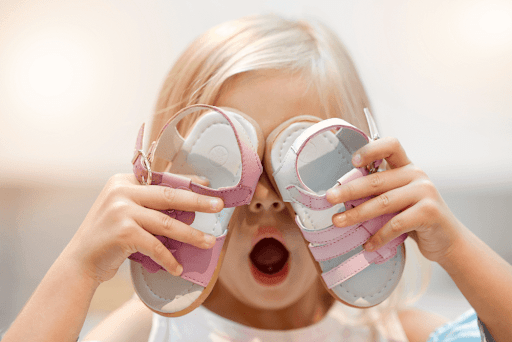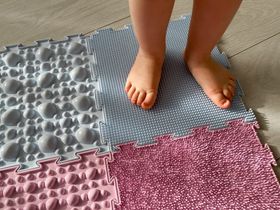7 Simple Exercises to Correct Toe Walking in Toddlers
Tired of seeing your toddler tiptoe around? Follow these step-by-step exercises for noticeable results
Updated December 5, 2024.

Does your toddler seem to dance on their tiptoes everywhere they go? Toe walking is a common phase many toddlers go through as they develop their walking skills. While it's typically normal before age three, persistent toe walking may indicate underlying issues that need attention. The good news is that several simple exercises can help correct this pattern.
Let's explore what toe walking means for your little one and the practical tips to encourage proper heel-to-toe walking.
» Support your child's foot health with shoes designed for toe walking
Understanding Toe Walking
Many toddlers naturally experiment with toe walking during their early walking journey as they discover different ways to move and balance. Common contributing factors include:
- Physical development variations can lead to temporary toe walking as children explore different movement patterns.
- Environmental influences such as bouncy surfaces or play activities might encourage toe-walking habits.
- Genetic factors may play a role, especially if there's a family history of toe walking.
» Learn how to pick shoes for different stages of your kid's development
Medical Considerations
Some cases of persistent toe walking may have underlying medical causes:
- Physical Constraints: Tight Achilles tendons or shortened calf muscles can limit proper heel strikes.
- Sensory Processing Differences: Some kids may prefer less ground contact with their feet.
- Neurological Conditions: Conditions like cerebral palsy often present with toe walking as one of their primary movement patterns.
» Check out our guide for finding shoes for kids with sensory issues
Why Early Intervention Matters
If left unaddressed, persistent toe walking can lead to several developmental challenges. Physical impacts may include muscle imbalances between the calf and front leg muscles and joint and tendon tightness that limits the range of motion. Over time, children might develop postural problems affecting their entire body alignment.
Long-term effects can include:
- Delayed development of gross motor skills
- Potential foot deformities from prolonged forefoot pressure
- Reduced participation in physical activities
- Social and emotional challenges as children become self-conscious
- Difficulties with balance and coordination
» Explore kids' shoes for orthotics and support your little one's foot health
7 Exercises to Correct Toe Walking
- Heel-to-Toe Walking Practice
- Calf Stretching Exercise
- Toe-to-Heel Rocking
- Ankle Range of Motion Exercise
- Towel Scrunching
- Heel Walks
- Foot Strengthening with Resistance Bands
1. Heel-to-Toe Walking Practice
One of the most fundamental exercises for correcting toe walking is practising proper heel-to-toe movement. This exercise works best on soft surfaces like grass or smooth, non-slip indoor flooring.
- Have your child stand barefoot with their feet hip-width apart.
- Guide them to walk slowly, ensuring their heel touches the ground first before rolling through to their toes.
- Hold their hands for support if needed, and practice walking across a room. As they gain confidence, gradually increase the distance.
This exercise helps your child develop awareness of their foot placement and strengthens the muscles needed for normal walking patterns.
Major physiological benefits include:
- Enhanced gait mechanics through proper heel-to-toe motion
- Improved balance and stability during movement
- Strengthened foot and calf muscles
- Increased ankle flexibility
» Encourage their adventures with the best walking shoes for kids
2. Calf Stretching Exercise
Tight calf muscles often contribute to toe walking, making regular stretching essential. This stretch is most effective when done barefoot on a stable surface like a yoga mat or carpet.
- Position your child facing a wall with their hands at shoulder height.
- Help them step one foot back while keeping the heel firmly on the ground.
- Gently guide them to lean forward, bending the front knee slightly until they feel a stretch in their back calf.
- Hold this position for 15–30 seconds, then switch sides.
- Repeat three to four times per leg.
Key benefits include:
- Increased flexibility in calf muscles and Achilles tendon
- Improved ankle mobility
- Reduced muscle tension for natural gait development
» Invest in supportive footwear to address your child's out-toeing
3. Toe-to-Heel Rocking
This dynamic exercise helps your child develop better control over their foot movements while strengthening essential muscle groups. A carpeted area or non-slip mat offers the best surface for this exercise.
- Start with your child standing barefoot with feet hip-width apart.
- Guide them to rise onto their toes and hold for three counts.
- Help them slowly shift their weight backwards, lowering their heels to the ground while slightly lifting their toes.
- Perform 10–15 controlled repetitions of this rocking motion.
Important benefits include:
- Enhanced muscular control during weight shifts
- Strengthened calf muscles for proper walking patterns
- Improved ankle flexibility for smooth movement transitions
» Learn if there a connection between ADHD and toe walking
4. Ankle Range of Motion Exercise
Improving ankle flexibility is crucial for developing proper walking patterns. This exercise should be performed barefoot to maximise effectiveness and can be done while watching television or during quiet play.
- Have your child sit comfortably on the floor with extended legs.
- Guide them through pointing their toes forward and then flexing their feet back toward their body.
- Next, help them make gentle circles with their ankles, both clockwise and counterclockwise.
- Aim for 8–10 repetitions of each movement.
Key advantages include:
- Increased ankle suppleness for better foot placement
- Improved blood flow to feet and lower legs
- Maintained joint health through a full range of motion
5. Towel Scrunching
This playful exercise strengthens the intrinsic muscles of the feet while making therapy time fun. This activity works best on hardwood or tile floors where the towel can slide easily.
- Place a small towel on a smooth surface and have your child sit with their feet flat on one end.
- Encourage them to use their toes to scrunch the towel toward them, gathering it bit by bit.
- To make it more engaging, place small toys on the towel for them to "collect" as they scrunch.
- Repeat this exercise 2–3 times, taking short breaks between sets.
Benefits include:
- Strengthened intrinsic foot muscles for arch support
- Enhanced toe control and flexibility
- Improved overall foot coordination
» Understand the connection between toe walking and autism
6. Heel Walks
Heel walking directly challenges toe walking patterns by strengthening opposing muscle groups. Depending on your child's comfort and environment, this exercise can be done barefoot or in flexible shoes.
- Have your child stand tall and walk on their heels while keeping their toes lifted off the ground.
- Guide them to maintain good posture and look forward as they walk short distances.
- Offer hand support for balance and encourage them to rest between walks.
- Aim for 3–5 repetitions across a safe, level surface.
Major benefits include:
- Strengthened anterior tibialis muscle for better heel-striking
- Enhanced overall balance
- Reduced tendency for toe walking
» Discover the best supportive sneakers for active playtimes
7. Foot Strengthening with Resistance Bands
Resistance band exercises can be particularly effective for older kids who can follow instructions well. These exercises should be done barefoot on a comfortable surface like a carpet or an exercise mat.
- Have your child sit on the floor with their legs extended.
- Wrap a gentle resistance band around the ball of one foot, helping them hold the ends.
- Guide them to point their toes away from their body, stretching the band, then slowly return to the starting position.
- Perform 10–15 repetitions per foot, keeping the resistance moderate to avoid strain.
Key benefits include:
- Increased strength in calf and ankle muscles
- Enhanced foot stability
- Improved joint range of motion
» See what shoes podiatrists approve for kids
A Step in the Right Direction
Fixing toe walking takes patience and consistency as you include these exercises into your daily routine. While every child's journey is unique, most show noticeable improvements in posture and movement within three to six months of dedicated practice.
Treating toe walking often means looking beyond exercises alone—the right shoes also play a crucial role. First Walkers shoes offer valuable stability through firm heel counters that encourage proper heel strikes, while their flexible soles allow for natural foot movement and muscle development.
Remember that keeping exercise sessions playful and cheerful makes all the difference as you work with your child. Consistent exercise, proper support, and a positive approach create the ideal environment for your child's development of healthy walking patterns.
» Explore shoes designed to address toe walking in kids with autism
Disclaimer: First Walkers' information is intended for educational and informational purposes related to toddler footwear and feet. We encourage you to consider individual circumstances and consult qualified orthopaedists about specific conditions.






